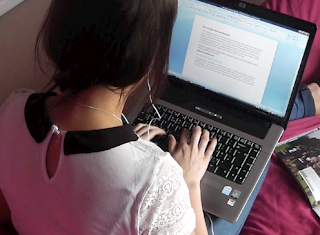Strengths
One of the strengths in our opening sequence is the first 30 seconds of the whole piece, i believe that the product would not be very good at all without it. It is personally my favourite and what i believe to be the best part of the media product. It is a mix of many different shots which are very short and put together using the technique of jump cuts. This looks very effective and helps to create the tension I was planning on building up the the action of the eye opening. It is fast and with all the different shots and angles it shows of the main character you get to see a lot in a very short period of time. The sound over these shots are, the heavy breathing which is created through both the character when we were filming and through a voice over. The other sound which is previewed is my most favourite bit, is the voice over of the curse being whispered out loud. It adds a sense of spookiness as we do not know if we can only hear the sound or whether the character can too and she is hearing things? This is not made clear to us, so yet again our imagination is put into place, as mystery arises. I really like the shot in the girls bedroom when she is reading the curse out loud and the camera follows behind her head. This gives the effect as if someone is watching her and she does not know, but we are in the point of view of the 'watcher'. It is different to just any other ordinary standard shot and i think this a reason to why i like it so much. I also think that the shots where the close up of the Ipod is shown is effective as it shows how well the clips were edited as they are all shown from different angles but they all however flow automatically with no awkwardness.
Weaknesses
I would say that one of the initial weaknesses of our product would be that the beginning bit may of been a bit too heavy, although it built tension and looked good, I do not know whether the opening should have gone straight into the rush of all of the clips together. This may have given the impression that the first cut had more of a trailer-feel than an opening, however when the second scene starts this changes, but I still had doubts on the first part being mistaken for a trailer. But no one did pick up on it in my audience feedback. Due to having to cut the whole piece down to two minutes some major cuts were made and not a lot of the narrative that originally I wanted to be included could be. So therefore to make sure that the piece fit within the two minute time frame the second scene had to have a basic storyline to make it all fit within the time i had left to show the narrative to the audience. So one of the weaknesses may be that the there was a lack of story behind the curse because of the time frame.
Improvements
If I were to do this project again, I think that I would introduce the story in a much more calmer way and then get into the jump cuts and build the tension up from there. As well as this i would want to have more time to put more narrative in about the curse so the audience could see what the effect of the curse would do to the main character.Also i would of improved our institution introduction, as i think it did not look as professional as ones that are successful today look, as well as it did not have a theme tune to start off with. It was more like a moving image with a title.
Overall
I think that overall, I have created a successful product. I like the end product that we have worked on, and even though there are some improvements that I would make if I were to do it again, I think that our product looks really and we have some very positive feedback to back this up with.













































